Tajweed Rules
Tajweed Rules with Images
This section discusses the basic rules of tajweed. Using correct makhrij, along with these rules, will make perfect Quran recitation. Students can also do practice during the Tajweed Class.
Tajweed Rules for Full Mouth letters /Huruf Tafkheem
Seven letters or huruf have full mouth sound, under all conditions. Alif will also read full mouth if it is after a full mouth letter. Example of these letters in words are:


Throat Letters or Huruf Halqi
These six letters are pronouncing from the throat. (Alif with harakah(zer, Zabar pesh) also called as hamza). The throat has three sections, bottom, middle, and top. These letters with examples are below:


Tajweed Rules for Huruf Madda /Madd Asli:
If zabar (fatha) comes before an alif or zer (kasra) before a yaa or a pesh (dhamma) before a wow, then the sound will lengthen for 1 second. (1 second is just for the guide. Practice from your teacher for accurate sound). Also an important Tajweed Rules. Examples of words with huroof e Madda are below:
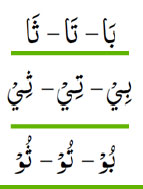

Standing fatha, kasra, and dhamma(Kari zabar,zer,pesh)
The sound for letters with karri Zabar(Standing fatha) Kari zer (standing kasra)or karri pesh(standing dhamma) will extend for 1 second.


Tajweed rules for Madd or Lengthen letters
Short madd
The short madd looks like a thin wavy line. Letters are lengthened for 2-3 seconds if madd appears.

Long Madd
The long Madd is thick and semi-circle in appearance. It lengthens for 4 seconds.

Madd with tashdeed and sakoon
A long madd on a letter and after that has a sakoon or tashdeed letter then; it lengthens for 5 seconds.

Nasal Sound (ghunnah)
Noon ( ن) or a Meem ( م) with a tashdeed on them then are lengthened for 1 second with a nasal sound or ghunna. In his make clear “n” sound for one second.

Echo letters (Qalqalah)
Five letters given below with a sukoon on them will make an echo sound. And if we stop on any of these letters, then also an echo sound will produce.


The rule for the word Allah
If fatha or dhamma is before the word Allah, then It is read full mouth. And if kasra (zer) is before, It will be read empty mouth.

The rule for letter Raw
- If a fatha or dhamma comes on the letter Raa ( ر) or the letter before it and raa is saakin, then it will be read full mouth.
- If kasra appears on letter Raa or the letter before it, when Raa is saakin, then it will be read empty mouth.

Signs of Stopping (Waqf)
In the Quran Pak, many signs for stopping or continuing reading appears. These are as below:
- If a small version of these letters appears, it means we must Stop. Basic Tajweed Rules.

- The small version of these letters and signs means we have the option to stop or carry on reading.

- The appearance of these signs and letters means to stop without breaking the breath. (On certain places)

- If this sign appears, don’t stop. Its is a common Tajweed Rules.

- A round circle at the end of the line means the end of a verse. Its also common Tajweed Rules observing.

- These set of two signs always appear together. It means to stop on either of one, not both. We can read in both ways, either option 1 or 2.
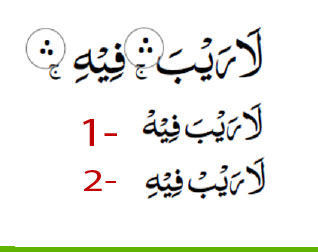
End of a verse (waqf)
At a point where the verse ends, harakah on letters decide how to stop.
- A single fatha, dhamma, or kasra at the end of the verse will replace it with a sukoon.
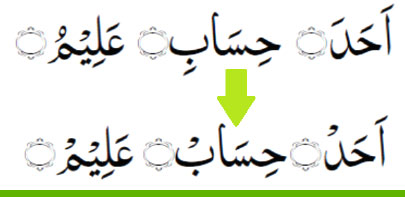
- If sakoon, kasratayn (two zer), or dhammatayn (two pesh) appears at the end of a word, then read it as a sukoon on the last letter.

- Incase fathatayn (two zabar) appears at the end of a verse, whether there is an alif attached to the word or not, take one fatha (zabar) off and read with an alif.
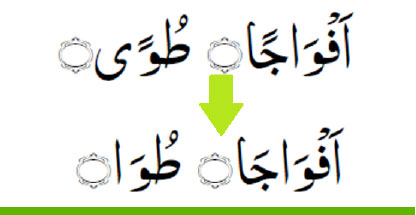
- If a word ends with alif or standing fatha (karri zabar) then read as it is written; no change will take place.

Round taa or haa with anything on them is read as haa saakin.
Noon saakin and Tanween
Where their Noon saakin and Tanveen appear, ceratin rules apply to the recitation of words. Four rules are:
1. IZ-HAAR 2. IQ-LAAB 3. ID-GHAAM 4. IKH-FAA
Noon Saakin
Noon saakin is Noon with sakun sign.
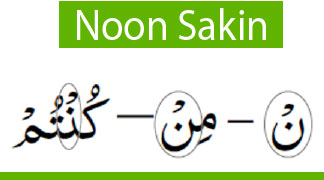
Tanveen
Tanveen is two fathas, dhammas or, kasras(Two zabar, two pesh , two zer).
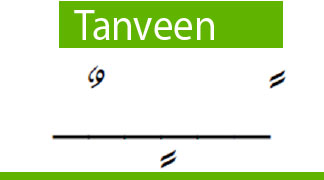
Tajweed rules of noon saakin and Tanveen
Four rules related to noon saakin and tanween are:
Iz-haar (to make clear)
Incase after the Noon saakin or Tanveen any of throat letters (ء،ه ،ع،ح،غ،خ)appear then read clearly with no sound change.
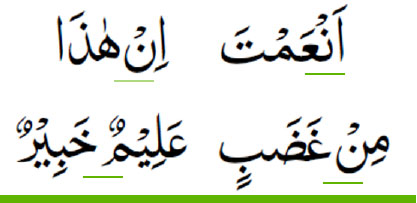
Iq-laab
Incase after letter noon saakin or tanveen BAA(ب) appears, then change them for Meem(م) and lengthen sound for one second.

Id-ghaaam (to merge)
If after letter noon saakin or tanveen four letters Wow, Meem, Noon, Yaa(و ,م , ن ,ي) appears then join letters and lengthen them for one second and produce a nasal sound.
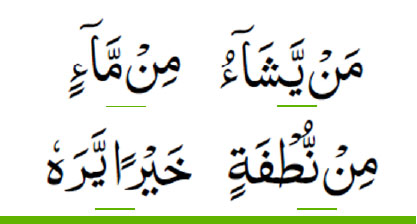
Certain words where noon saakin and tanveen follow these four letters but, no idgham occur because they appear in one word.

Ikh-faa (to hide)
If after letter noon saakin or Tanveen any of fifteen letters given below appears, then make light nasal sound and lengthen for one second.

